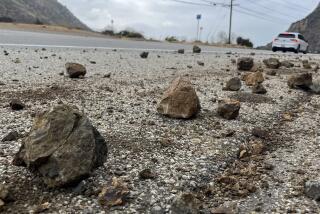Usable Quake Predictions Near Reality, Official Says
- Share via
A state safety official said Thursday that scientists are approaching the point of predicting earthquakes with enough accuracy that non-essential businesses could be directed to close and residents could be advised to remain in their homes to prepare for a possible quake.
Richard Andrews, assistant director for Southern California for the state Office of Emergency Services, said such a warning could be given in urban areas if scientists determined there was a 50% or greater chance of a major earthquake within an upcoming 72-hour period. He did not specify when he thought officials might be able to make predictions with that level of accuracy, however.
“I don’t think science has reached the point yet where we’re going to get a 50% probability, but we might be able to assign a 37.5% probability,” Andrews told an earthquake preparedness seminar at Caltech.
However, Caltech seismologist Kate Hutton disputed Andrews’ contention, indicating that he was too optimistic about the prospects of earthquake predictions.
“I don’t think we’re very far along at all in making high probability predictions,” she said.
Andrews and Hutton spoke at the seminar for the news media jointly sponsored by Caltech and a number of Southern California utility companies.
Andrews said that careful study of quakes in the 3- to 4-point magnitude range, including assessment of such factors as the creep of earthquake epicenters toward major faults such as the San Andreas, can establish a likely fore-shock pattern. Eventually such patterns will be well enough understood to allow scientists to assign probabilities of a major earthquake.
“We are attempting to be very attentive to quake sequences. We don’t want to be criticized for dithering, not paying attention to fore-shocks, if a big one does strike,” he said.
Andrews cited the 5.9 magnitude north Palm Springs earthquake of July 8, 1986, and the 6.2 Superstition Hills (Imperial Valley) earthquake Nov. 23, 1987, as examples of earthquakes that had aroused concern among state emergency officials that they might be followed by larger temblors.
In fact, the Superstition Hills quake was followed the next day by a 6.6 quake.
Short-term earthquake predictions may well be valid soon, Andrews said, “but we know the danger of pushing scientists to predictions they are not prepared to make.”
Hutton followed Andrews at the seminar, saying that the prospects for earthquake predictability is now limited to areas known to be most vulnerable to earthquakes, such as the Imperial Valley. Moreover, she said, even in those areas scientists are reluctant to suggest anything more than 10% to 15% probability of a quake in any given instance, and then only after a major shock such as the one of Nov. 23, 1987.
Later, Tom Heaton, head of the U.S. Geological Survey’s Southern California field office, said in a telephone interview that he felt the highest percentage of short-term quake probability that can be assigned in Southern California at this time is only 10%.
“It changes with the region,” he said. “In Parkfield (in Central California, an area of frequent earthquakes), there are some conditions under which scientists may be able to state a 50% probability within a set time period of days.”
More to Read
Sign up for Essential California
The most important California stories and recommendations in your inbox every morning.
You may occasionally receive promotional content from the Los Angeles Times.










